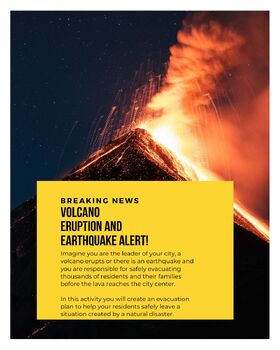Volcano/Earthquake Eruption Safety Plan--Upgraded!!!
- PDF
Description
CALLING ALL SCIENCE TEACHERS Junior High and High School!!!
When you are gifted an incredible group of inquisitive minds who want to delve into the worse-case scenarios, you want to give them a project they can really sink their teeth into!
This project was created for students who are willing to take on the challenge of formulating an evacuation plan in the event of a major volcanic eruption in the US (we used Mt. Ranier in Washington State, you can also use Yellowstone or Mt. St. Helens) or Earthquake (we used Portland, OR as a city to evacuate given it's place on the Juan de Fuca plate).
You will be amazed to see the creative ideas this project will inspire. This project will impact them because they will have to think about the totality of a natural disaster and how it could affect their community.
This project requires:
1. Research on plate tectonics/volcanoes (depending on what the students choose)
2. Careful planning and organization of thought
3. Reflection of how the project impacted them
Thank you for your support!!
Students will apply scientific knowledge of earthquakes to the hypothetical event an earthquake/volcanic eruption has occurred. They will first present a brief overview of the science of earthquakes or volcanoes, then research considerations (i.e. how to distribute and mobilize resources, who will be the first to evacuated what types of buildings are more dangerous than others, etc), and finally create a five-phase plan for evacuation. The project concludes with a brief reflection of how thinking about the impact of earthquakes affected them as they had to consider the consequences on such a large scale.
This project should be researched in school so the students receive full support.
The objective is to apply scientific knowledge to a real-life situation and critically think about factors affecting public safety.


